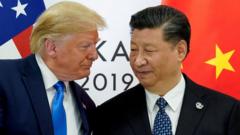Recent GDP figures indicate India's economy is slowing down, with a 5.4% growth rate, as consumer demand wanes and inflation rises. Experts warn that without significant reforms and investment, India's two-speed economy may struggle to maintain its growth trajectory.
India’s Economic Growth Stumbles Amid Rising Inflation and Weakening Demand

India’s Economic Growth Stumbles Amid Rising Inflation and Weakening Demand
A closer look at the recent decline in India’s GDP, which fell to 5.4%, highlighting the challenges faced by the nation's economy amidst high inflation and shifting consumer dynamics.
India, known as the world's fastest-growing large economy, has encountered a significant slowdown, evidenced by the latest GDP figures that reveal a drop to 5.4% between July and September - the lowest in seven quarters. This figure stands in stark contrast to the Reserve Bank of India's (RBI) forecast of 7% and, while comparatively robust against developed nations, suggests deeper economic issues at play.
Economists attribute this downturn to a myriad of factors. A lack of consumer demand has dampened spending while private investment remains constrained. Additionally, government expenditures, which have been key drivers of growth over recent periods, are declining. India's goods exports continue to struggle, making up an insignificant 2% of total exports in 2023. Meanwhile, sales in the Fast-Moving Consumer Goods (FMCG) sector reflect tepid performance, and urban wages, as indicated by the salary bills of publicly traded firms, have also diminished.
Despite these challenges, India's Finance Minister Nirmala Sitharaman remains optimistic, asserting that the decline should not be viewed as systemic but rather as a consequence of reduced government spending during an election-focused quarter. She anticipates growth in the third quarter to counterbalance recent declines, claiming India will maintain its status as the fastest-growing major economy.
Moreover, inflation surged to 6.2% in October, exceeding the RBI's target and attributed to rising food costs, particularly vegetables, which saw a spike of over 40%. High inflation has prompted the central bank to maintain high-interest rates for nearly two years, raising concerns from economists who warn that such policies may hinder growth. Critics argue that elevated borrowing costs limit investments and consumer spending, both crucial for economic expansion.
The economy appears to operate on a "two-speed trajectory," characterized by stagnation in the traditional sectors while the modern, service-oriented economy thrives. The informal sector and structures from the old economy are lagging, awaiting necessary reforms to foster growth, while the service sector has seen explosive growth, becoming a hub for global capability centers. Deloitte reports over 50% of these centers are located in India, significantly bolstering urban consumption.
However, the problem lies in the diminishing impact of this consumption surge as the novelty fades. Economists like Rajeshwari Sengupta highlight the cyclical nature of investment and consumption, stating that without robust demand, private investment will not flourish, thereby stifling job creation.
Other complicating factors including rising tariffs, which have increased from 5% in 2013 to 17% currently, add to export competitiveness concerns. As the RBI intervenes to stabilize the rupee, it inadvertently tightens liquidity—further challenging the business environment.
While government officials tout India's banking strength and stable finances, skepticism persists. Pathways forward might include increasing wages through employment schemes and reforming tariffs to attract investment from nations seeking alternatives to China.
In summary, while India's economy has vital strengths, the recent slowdown underscores the pressing need for strategic reforms and sustained efforts to bolster consumption and investment. As the government promotes the narrative of India's growth, the call for tangible change grows louder in order to truly fulfill the nation’s ambitious economic goals.























